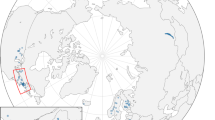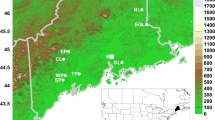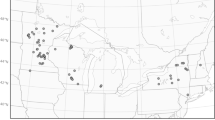Abstract
An analysis is presented of 46 ice break up and 15 ice free season phenology data series obtained largely through volunteer monitoring efforts in Southern Ontario. Observations spanned the years 1853–2001. Available data included dates of ice formation and ice break up as well as the number of ice free days in a year. A high degree of temporal coherence in ice phenology between lakes was observed (137/365 pairwise correlations significant at P<0.05). Significant monotonic trends towards earlier break up dates and longer ice free seasons were observed across the region both in the entire series and in the last thirty years of data. Trends in longer series may be associated with the end of the Little Ice Age. The significantly longer ice free seasons and earlier ice break up dates observed in the study area have important implications for lakes in other parts of Canada where climate change effects are predicted to be more extreme than in South-Central Ontario.
Similar content being viewed by others

References
Anderson, W. L., Robertson, D. M. and Magnuson, J. J.: 1996, ‘Evidence of recent warming and El-Nino related variations in ice breakup of Wisconsin lakes’, Limnol. Oceanogr. 41(5), 815–821.
Assel, R. A. and Robertson, D. M.: 1995, ‘Changes in winter air temperatures near Lake Michigan, 1851–1993 as determined from regional lake ice records’, Limnol. Oceanogr. 40(1), 165–176.
Benson, B. and Magnuson, J.: 2000, ‘Global Lake and River Ice Phenology Database’, Boulder, CO: National Snow and Ice Data Center/World Data Center for Glaciology, Boulder, Digital media.
Burroughs, W. J.: 1992, ‘Weather Cycles: Real or Imaginary’, Cambridge University Press, Cambridge, 207 pp.
Hamed, K. H. and Rao, A. R.: 1998, ‘A modified Mann-Kendall trend test for autocorrelated data’, J. Hydrol. 204, 182–196.
Luckman, B. H.: 1994, ‘Using multiple high-resolution proxy climate records to examine natural climatic variation: an example from the Canadian Rockies’, in Mountain Environments in Changing Climates, M. Beniston (ed.) Routledge, London, pp 44–59.
Magnuson, J. J., Benson, B. J., Kratz, T. K.: 1990, ‘Temporal coherence in the limnology of a suite of lakes in Wisconsin, U.S.A.’, Freshwater Biol. 23, 145–159.
Magnuson, J. J., Robertson, D. M., Benson, B. J., Wynne, R. H., Livingstone, D. M., Arai, T., Assel, R. A., Barry, R. G., Card, V., Kuusisto, E., Granin, N. G., Prowse, T. D., Stewart, K. M. and Vuglinski, V. S.: 2000, ‘Historical trends in lake and river ice cover in the northern hemisphere’, Science 289, 1743–1746.
Magnuson, J. J., Wynne, R. H., Benson, B. J. and Robertson, D. M.: 2001, ‘Lake and river ice as a powerful indicator of past and present climates’, Verh. Int. Ver. Limnol. 27, 2749–2756.
Ostrom, C. W. Jr.: 1990, ‘Time Series Analysis. Sage University Papers Series on Quantitative Applications in the Social Sciences’, 07–009 Thousand Oaks, CA.
Rannie, W. I.: 1983, ‘Breakup and freezeup of the Red River at Winnipeg, Manitoba Canada in the 19th century and some climatic implications’, Climatic Change 21, 407–427.
Robertson, D. M., Ragotzkie, R. A. and Magnuson, J. J.: 1992, ‘Lake ice records used to detect historical and future climatic changes’, Climatic Change 21, 407–427.
Skinner, W. R.: 1992, ‘Lake ice conditions as a cryospheric indicator for detecting climatic variability in Canada’, Can. Clim. Cent. Rep. 92-4, 46 pp. Atmos. Environ. Serv., Downsview, Ont., Canada.
USEPA: 2000, ‘Practical Methods for Data Analysis’. EPA QA/G-9. Environmental Protection Agency, Washington, 219 pp.
Wynne, R. H.: 2001, ‘Statistical modeling of lake ice phenology: Issues and implications’, Verh. Int. Ver. Limnol. 27, 2820–2825.
Wynne, R. H., Magnuson, J. J., Clayton, M. K., Lillesand, T. M. and Rodman, D. C.: 1996, ‘Determinants of temporal coherence in the satellite derived 1987–1994 ice breakup of lakes on the Laurentian Shield’, Limnol. Oceanogr. 41(5), 832–838.
Zhang, X., Harvey, K. D., Hogg, W. D. and Yuzyk, T. R.: 2001, ‘Trends in Canadian streamflow’ Water Res. Res. 37(4), 987–998.
Author information
Authors and Affiliations
Rights and permissions
About this article
Cite this article
Futter, M.N. Patterns and Trends in Southern Ontario Lake ice Phenology. Environ Monit Assess 88, 431–444 (2003). https://doi.org/10.1023/A:1025549913965
Issue Date:
DOI: https://doi.org/10.1023/A:1025549913965



